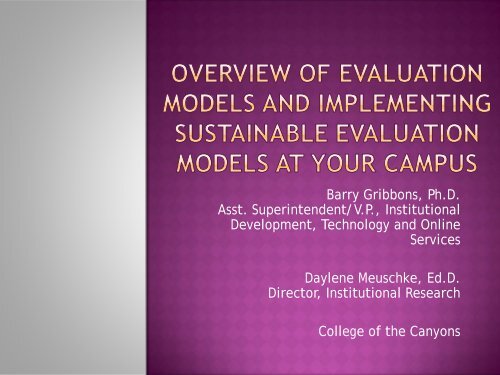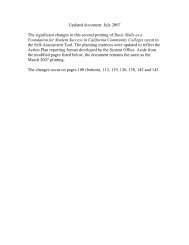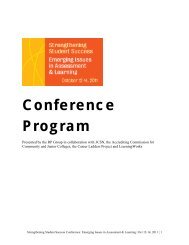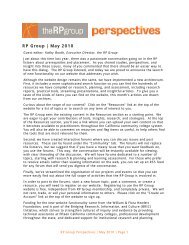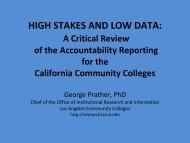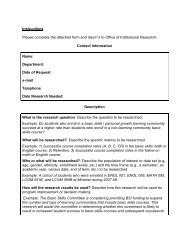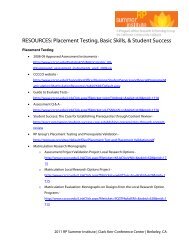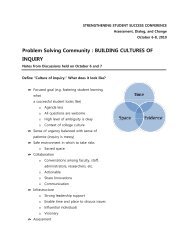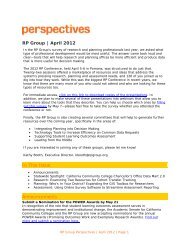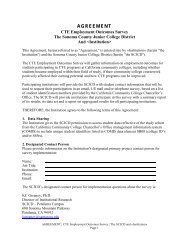Implementing Program Evaluation Models ... - The RP Group
Implementing Program Evaluation Models ... - The RP Group
Implementing Program Evaluation Models ... - The RP Group
You also want an ePaper? Increase the reach of your titles
YUMPU automatically turns print PDFs into web optimized ePapers that Google loves.
Barry Gribbons, Ph.D.<br />
Asst. Superintendent/V.P., Institutional<br />
Development, Technology and Online<br />
Services<br />
Daylene Meuschke, Ed.D.<br />
Director, Institutional Research<br />
College of the Canyons
Mathematics, Engineering, Science<br />
Achievement (MESA) is nationally recognized<br />
for its innovative and effective academic<br />
development program. MESA engages<br />
thousands of educationally disadvantaged<br />
students so they excel in math and science<br />
and graduate with math-based degrees. MESA<br />
partners with all segments of California<br />
higher education as well as K-12 institutions.
Types of <strong>Evaluation</strong> <strong>Models</strong>:<br />
• Objectives-Oriented<br />
• Consumer-Oriented<br />
• Goals-Free<br />
• <strong>Evaluation</strong> Research<br />
• User-Oriented<br />
• Decision-Oriented<br />
• CIPP<br />
• Kirkpatrick’s evaluation<br />
Collaborative Research Model Using CIPP<br />
Model and Microsoft OneNote.
<strong>The</strong> American <strong>Evaluation</strong> Association Guiding Principles<br />
• Systematic Inquiry: Evaluators conduct systematic, data-based<br />
inquiries.<br />
• Competence: Evaluators provide competent performance to<br />
stakeholders.<br />
• Integrity/Honesty: Evaluators display honesty and integrity in<br />
their own behavior, and attempt to ensure the honesty and<br />
integrity of the entire evaluation process.<br />
• Respect for People: Evaluators respect the security, dignity, and<br />
self-worth of respondents, program participants, clients, and other<br />
evaluation stakeholders.<br />
• Responsibilities for General and Public Welfare: Evaluators<br />
articulate and take into account the diversity of general and<br />
public interests and values.
Attributed to Ralph Tyler, beginning around<br />
1930.<br />
Focuses on behavioral objectives.<br />
Determines extent to which goals and<br />
objectives have been achieved.<br />
Has common-sense appeal/simplicity.<br />
Has narrow focus, only including objectives<br />
identified.<br />
Adaptated by Metfessel and Micheal (1967),<br />
Provus (1973), and Hammond (1973) to<br />
address narrow focus and other limitations.
Determines the relative value of various<br />
programs (or goods).<br />
Used for educational curricula or packages.<br />
Often includes achievement of objectives<br />
(intended, unintended, cognitive, noncognitive)<br />
and costs.<br />
Is similar to Consumer Reports.<br />
Relies on credibility and expertise of evaluator<br />
(this is critical).<br />
Produces limited information on improving<br />
services.
Assesses program effects irrespective of<br />
program’s conceptual framework and a priori<br />
objectives.<br />
In the hands of skilled evaluators, reduces<br />
bias.<br />
Measures unintended as well as intended<br />
outcomes.<br />
Concern: Type I error analogy.
Focus is on:<br />
• Explaining educational effects.<br />
• Devising instructional strategies.<br />
• Threats to internal and external validity.<br />
Oxymoron?
Developed in the 1970s.<br />
Emphasizes utility: what information is most<br />
helpful to stakeholders.<br />
Engages stakeholders (e.g. part of evaluation<br />
team) so information is used.<br />
• Framing evaluation<br />
• Previewing results and participating in the<br />
interpretation<br />
Other major elements include:<br />
• Rapport-building<br />
• Understanding contextual factors<br />
• Organizational structure and function<br />
• Accessibility and timing of results
aka Management-oriented.<br />
Focuses on informing decisions.<br />
Encourages use of results.<br />
Sample questions include:<br />
What need is being addressed by the program?<br />
Who is the program helping (and who it is not)?<br />
What interventions are being considered? Which<br />
have been selected?<br />
How is the program being implemented? What<br />
adaptations are being made and why?<br />
What are the effects of the programs?<br />
What improvements can be made for the future?
Context<br />
• What needs to be done?<br />
Input<br />
• How should it be done?<br />
Process<br />
• Is it being done?<br />
Product<br />
• Did it succeed?
Emphasizes improving programs at multiple<br />
stages and collecting summative information.<br />
Engages stakeholders.<br />
Laborious and costly, but worth it.
Four levels of outcomes:<br />
1. Reaction to curriculum and training process.<br />
2. Knowledge or skill acquisition (learning).<br />
3. Behavior change.<br />
4. Improvement in individual or organizational<br />
outcomes (results).
Engage Stakeholders<br />
Listen to their needs<br />
Discuss framework, purpose, and USE<br />
• Improve program<br />
• Accountability<br />
• Advocacy<br />
<strong>Evaluation</strong> Deliverables<br />
• Accessible<br />
• Timely
Based on CIPP and Kirkpatrick’s <strong>Models</strong>.<br />
Used to evaluate all basic skills funded<br />
projects.<br />
Developed in collaboration with Assoc. V.P.,<br />
Academic Affairs, English Faculty/Basic Skills<br />
Faculty Coordinator and Research.<br />
All staff and faculty on the Skills4Success<br />
committee can review and contribute<br />
content.<br />
Microsoft OneNote serves as the vehicle for<br />
sharing evaluation model.
<strong>Evaluation</strong> Elements:<br />
• <strong>Program</strong> Description<br />
• <strong>Program</strong> Need<br />
• Coordination with existing programs<br />
• Summary of existing data<br />
• Objectives<br />
• Evidence and description of how the<br />
project/program has been implemented<br />
• Evidence of changes in the classroom<br />
• Degree to which outcomes were achieved<br />
• Future changes planned for the program<br />
• Plans for institutionalization
Demo OneNote
Stage 1:<br />
Process and<br />
Objective<br />
Implementation<br />
•Level 1 (1 pt)-Developing<br />
(Less than 70% of objectives have been clearly<br />
defined.)<br />
•Level 2 (2 pts)-In Progress<br />
(70% or more of the objectives are in the process of<br />
being implemented and evidence is being<br />
collected.)<br />
•Level 3 (3 pts)-Completed<br />
(70% or more of the objectives have been<br />
completed and evidence of the implementation has<br />
been collected.)
Stage 2:<br />
Demonstration of<br />
Classroom/<br />
Services<br />
Implementation<br />
•Level 1 (4 pts)-Developing<br />
(Projects meet Stage 1, level 3 and they are<br />
beginning to collect direct evidence of the impact<br />
on classroom activities or services to students.)<br />
•Level 2 (5 pts)-In Progress<br />
(Direct evidence of the impact on classroom<br />
activities or services to students has been<br />
collected for at least 50% of the activities.)<br />
•Level 3 (6 pts)-Completed<br />
(Direct evidence of the impact on classroom<br />
activities or services to students has been<br />
collected for at least 70% of the activities.)
Stage 3:<br />
Stated<br />
Outcome<br />
Improvement<br />
•Level 1 (7 pts)-Developing<br />
(Projects must achieve Stage 2, level 3 and they<br />
show little change in student achievement.)<br />
•Level 2 (8 pts)-In Progress<br />
(<strong>The</strong>re is some evidence of impact on student<br />
achievement.)<br />
•Level 3 (9 pts)-Completed<br />
(<strong>The</strong>re is a lot of evidence that there is impact on<br />
student achievement.)
Basic Skills <strong>Evaluation</strong> Model has been<br />
adapted for…<br />
• Professional Development <strong>Program</strong> <strong>Evaluation</strong>.<br />
• Adult Re-Entry <strong>Program</strong> <strong>Evaluation</strong>.
Any questions or comments?


